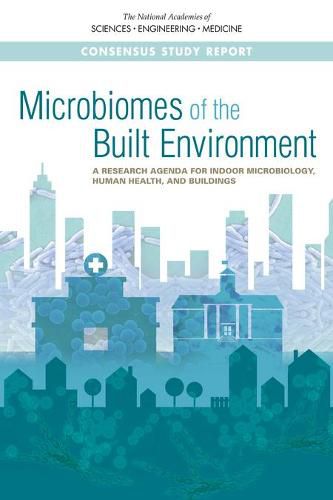Readings Newsletter
Become a Readings Member to make your shopping experience even easier.
Sign in or sign up for free!
You’re not far away from qualifying for FREE standard shipping within Australia
You’ve qualified for FREE standard shipping within Australia
The cart is loading…






People’s desire to understand the environments in which they live is a natural one. People spend most of their time in spaces and structures designed, built, and managed by humans, and it is estimated that people in developed countries now spend 90 percent of their lives indoors. As people move from homes to workplaces, traveling in cars and on transit systems, microorganisms are continually with and around them. The human-associated microbes that are shed, along with the human behaviors that affect their transport and removal, make significant contributions to the diversity of the indoor microbiome.
The characteristics of healthy indoor environments cannot yet be defined, nor do microbial, clinical, and building researchers yet understand how to modify features of indoor environments?such as building ventilation systems and the chemistry of building materials?in ways that would have predictable impacts on microbial communities to promote health and prevent disease. The factors that affect the environments within buildings, the ways in which building characteristics influence the composition and function of indoor microbial communities, and the ways in which these microbial communities relate to human health and well-being are extraordinarily complex and can be explored only as a dynamic, interconnected ecosystem by engaging the fields of microbial biology and ecology, chemistry, building science, and human physiology.
This report reviews what is known about the intersection of these disciplines, and how new tools may facilitate advances in understanding the ecosystem of built environments, indoor microbiomes, and effects on human health and well-being. It offers a research agenda to generate the information needed so that stakeholders with an interest in understanding the impacts of built environments will be able to make more informed decisions.
$9.00 standard shipping within Australia
FREE standard shipping within Australia for orders over $100.00
Express & International shipping calculated at checkout
Stock availability can be subject to change without notice. We recommend calling the shop or contacting our online team to check availability of low stock items. Please see our Shopping Online page for more details.
People’s desire to understand the environments in which they live is a natural one. People spend most of their time in spaces and structures designed, built, and managed by humans, and it is estimated that people in developed countries now spend 90 percent of their lives indoors. As people move from homes to workplaces, traveling in cars and on transit systems, microorganisms are continually with and around them. The human-associated microbes that are shed, along with the human behaviors that affect their transport and removal, make significant contributions to the diversity of the indoor microbiome.
The characteristics of healthy indoor environments cannot yet be defined, nor do microbial, clinical, and building researchers yet understand how to modify features of indoor environments?such as building ventilation systems and the chemistry of building materials?in ways that would have predictable impacts on microbial communities to promote health and prevent disease. The factors that affect the environments within buildings, the ways in which building characteristics influence the composition and function of indoor microbial communities, and the ways in which these microbial communities relate to human health and well-being are extraordinarily complex and can be explored only as a dynamic, interconnected ecosystem by engaging the fields of microbial biology and ecology, chemistry, building science, and human physiology.
This report reviews what is known about the intersection of these disciplines, and how new tools may facilitate advances in understanding the ecosystem of built environments, indoor microbiomes, and effects on human health and well-being. It offers a research agenda to generate the information needed so that stakeholders with an interest in understanding the impacts of built environments will be able to make more informed decisions.